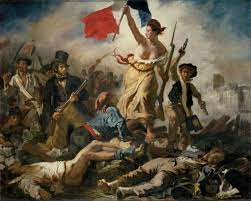AP World History: Modern 🌍
577 resourcesSee Units
Multiple Choice Practice for Revolutions
Welcome to Unit 5 AP World History Multiple Choice Questions! Grab some paper and a pencil 📄 to record your answers as you go. You can see how you did on the Unit 5 Practice Questions Answers and Review sheet once you're done. Don't worry, we have tons of resources available if you get stumped 😕 on a question. And if solo study is not your thing, join a group in Rooms.
Not ready to take a quiz yet? Start studying unit 5 here: Intro to Unit 5

Image From Wikipedia
Facts about the test: The AP World History exam has 55 multiple choice questions and you will be given 55 minutes to complete the section. That means it should take you around 15 minutes to complete 15 questions.
*The following questions were not written by CollegeBoard and although they cover information outlined in the AP World History Course and Exam Description the formatting on the exam may be different.
1. The writings of the 18th–century French philosophers Rousseau, Voltaire, and Diderot influenced the
A. failure of the German unification movement
B. spread of imperialism to Africa and Asia
C. revolutionary movements in Europe and the Americas.
D. start of the Neolithic Revolution
2. Before the French Revolution, the people of France were divided into three estates based mainly on their
A. geographic region
B. religious beliefs
C. career field
D. wealth
3. In the period from 1750 to 1850, which of the following political ideologies was gaining increasing influence in western Europe and parts of the Atlantic world?
A. Absolutism
B. Liberalism
C. Fascism
D. Totalitarianism
4. The United States Bill of Rights and the French Declaration of the Rights of Man and Citizen reflect a shared concern for
A. protection of personal liberty
B. establishment of a parliamentary system
C. preservation of the monarchy
D. keeping monarchical power strong, but limited
5. The MOST important ECONOMIC privilege enjoyed by the clergy and nobility BEFORE the French Revolution was
A. exemption from taxes to the state
B. ownership of land
C. the right to collect dues
D. the right to finance wars
6. Latin American Revolutions were MOSTLY initiated by the
A. Mestizos
B. Creoles
C. Mulattoes
D. the Peninsulares
7. The only successful slave-led political revolution took place in
A. Venezuela
B. Mexico
C. Haiti
D. Brazil
8. One similarity that existed before AND after Latin American revolutions was
A. Creoles continued to feel their natural rights weren't being protected
B. voting rights continued to only be offered to Peninsulares
C. European rulers were still able to exert significant influence in Latin America
D. conditions for the lower classes continued to be poor
9. The Industrial Revolution marked a dramatic change in
A. how trade was conducted
B. the way products were made
C. the use of currency as a form of payment
D. the economic rights of citizens
10. All of the following were reasons that the Industrial Revolution began in Britain EXCEPT
A. Britain's transportation infrastructure was capable of moving goods
B. British citizens had excess capital to invest in industrial development
C. Britain was rich in raw materials such as coal and iron
D. The British government funded industrial development
11. Which of the following technologies was MOST responsible for spurring industrial production in England?
A. Steam Engine
B. Power Loom
C. Spinning Jenny
D. Cotton Gin
12. All of the following were changes caused by the Industrial Revolution EXCEPT:
A. Creation of a new middle class
B. Environmental degradation
C. More economic equality between all social classes
D. Development of new economic systems
13. Which of the following groups saw an increase in some forms of independence, as a result of the Industrial Revolution?
A. Women
B. Men
C. Children
D. Elderly
14. The Industrial Revolution's success in Britain led to the revolution being spread to which following pair of nations?
A. Nigeria and China
B. Japan and Russia
C. Venezuela and Korea
D. Mongolia and Australia
15. A key difference between British and Japanese industrialization was
A. Industrial production focused on textiles in Britain while it focused on machine parts in Japan
B. Factory workers in Britain were both male and female, while workers in Japan were solely men
C. Industrialization was funded by individuals in Britain, while it was funded by the government in Japan
D. Industrialization was successful in Britain, but was not successful in Japan
Time to Check Your Answers on Unit 5 Practice Questions Answers and Review! 🙌
Browse Study Guides By Unit
🐎Unit 1 – The Global Tapestry, 1200-1450
🐫Unit 2 – Networks of Exchange, 1200-1450
🕌Unit 3 – Land-Based Empires, 1450-1750
🍕Unit 4 – Transoceanic Interactions, 1450-1750
✊🏽Unit 5 – Revolutions, 1750-1900
🚂Unit 6 – Consequences of Industrialization, 1750-1900
💣Unit 7 – Global Conflict, 1900-Present
🥶Unit 8 – Cold War & Decolonization, 1900-Present
✈️Unit 9 – Globalization, 1900-Present
✏️Frequently Asked Questions
🤔Exam Skills
👉🏼Subject Guides
📝AMSCO Notes

Fiveable
Resources
© 2025 Fiveable Inc. All rights reserved.